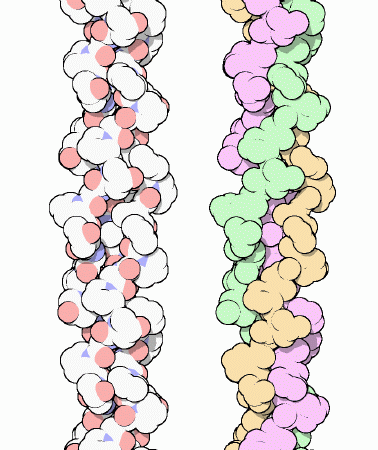|
Inhaltsübersicht | Nanomaschinen | Moleküle | Programme | Kurse | Fun | Links |
||
| > |
Collagen

Your Most Plentiful Protein
About one quarter of all of the protein in your body is collagen. Collagen is a major structural protein, forming molecular cables that strengthen the tendons and vast, resilient sheets that support the skin and internal organs. Bones and teeth are made by adding mineral crystals to collagen. Collagen provides structure to our bodies, protecting and supporting the softer tissues and connecting them with the skeleton. But, in spite of its critical function in the body, collagen is a relatively simple protein.The Collagen Triple Helix
Collagen is composed of three chains, wound together in a tight triple helix. The illustration included here shows only a small segment of the entire molecule--each chain is over 1400 amino acids long and only about 20 are shown here. A repeated sequence of three amino acids forms this sturdy structure. Every third amino acid is glycine, a small amino acid that fits perfectly inside the helix. Many of the remaining positions in the chain are filled by two unexpected amino acids: proline and a modified version of proline, hydroxyproline. We wouldn't expect proline to be this common, because it forms a kink in the polypeptide chain that is difficult to accommodate in typical globular proteins. But, as you can see on the next page, it seems to be just the right shape for this structural protein.Vitamin C
Hydroxyproline, which is critical for collagen stability, is created by modifying normal proline amino acids after the collagen chain is built. The reaction requires vitamin C to assist in the addition of oxygen. Unfortunately, we cannot make vitamin C within our bodies, and if we don't get enough in our diet, the results can be disastrous. Vitamin C deficiency slows the production of hydroxyproline and stops the construction of new collagen, ultimately causing scurvy. The symptoms of scurvy--loss of teeth and easy bruising-- are caused by the lack of collagen to repair the wear-and-tear caused by everyday activities.Collagen on the Grocery Shelf
Collagen from livestock animals is a familiar ingredient for cooking. Like most proteins, when collagen is heated, it loses all of its structure. The triple helix unwinds and the chains separate. Then, when this denatured mass of tangled chains cools down, it soaks up all of the surrounding water like a sponge, forming gelatin.
Next: Exploring the Structure
Last changed by: A.Honegger,